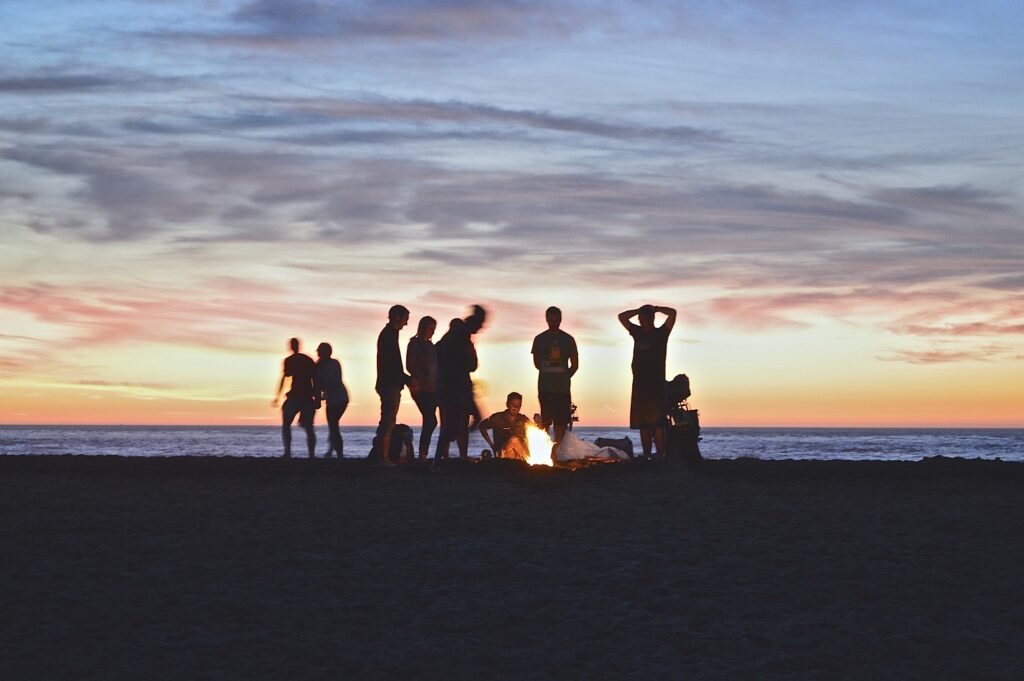While it may sound glamorous on the surface, working from home is actually f*cking hard. It’s definitely not for everyone. Long-term remote work can cripple motivation, suffocate productivity, and lead to a host of mental health challenges.
I am not an organizational psychologist nor a human resources professional. But I have been working remotely since 2012. During that time, I’ve learned a great deal about working from home and how to mitigate its unexpected and inevitable challenges.

On the plus side, working remotely can offer a wealth of freedom and flexibility. But in many cases, it can involve long days working from one place. Fortunately, there are many things you can do to hack work from home confinement. So below, I’ve distilled ten things that help me stay motivated, productive, and inspired.
1. Frequent cold exposure

There are many good reasons why cold exposure has become trendy over the years. Most popular for boosting metabolism and weight loss, a cold shower or winter river plunge can also be a powerful way to hack one’s mental health. For me, it’s nature’s best antidepressant.
Here are some of the benefits of cold exposure, many of which are backed by science:
- boosts energy levels
- speeds-up metabolism
- improves immune response
- reduces inflammation
- enhances quality of sleep
- helps with swelling, sore muscles, and athletic recovery
Thanks to pioneers like Wim Hof and others like Tim Ferriss and Ben Greenfield who have popularized cold exposure (or “cold thermogenesis”), more and more research is being invested in this ancient practice.
Of course, it is very uncomfortable at first, but the effect it has on one’s body chemistry cannot be denied. Whether it’s a morning cold shower or dip in the lake during wintertime, frequent cold exposure is more than just a remote worker’s hack. It’s a biohack to healthier living.
2. A solid social support group
We all need some degree of socialization. While in-person interaction is ideal, even digital communication can suffice.
I am not talking about the socialization you get from coworkers, customers or colleagues. But rather, the friends and family members who you can connect with more meaningfully.

I am talking about the people you can share scandalous memes with. The buddies whom you kick back a few beers with. Or the comrades who share similar passions as you, like riding bikes, going camping, or getting jacked at the gym.
Working from home makes it especially difficult to fulfill one’s social needs. Get out there and build a social support group that you can grow with for years to come.
3. Mindfulness breaks
Some amount of stress can be motivating and healthy. But when work-related stress escalates (which can happen all too quickly) work can quickly become overwhelming.
There are many different ways stress can negatively impact your work and how you feel. For me, sometimes work-related stress becomes so overwhelming that it’s paralyzing, thereby halting all motivation and productivity.

That’s when mindfulness breaks come into play. These short yet powerful breaks design to help alleviate stress and enable you to regain clarity and composure throughout the day. And the beautiful part is, there are no rigid rules on how to do it.
I personally use an abbreviated version of mindfulness meditation at the start of my day, as well as throughout my day as needed. This involves thoughtless, mindful breathing in which I take a few moments to observe my breath.
Five minutes of mindful breathing is a powerful way to help me dissapate stress and stay anchored. This practice can be used in conjuction with or substituted for other techniques, like:
- Noticing your senses, such as areas of tension and relaxation or warmth and coolness.
- Acknowledging your emotions. For instance, if you’re feeling lonely, you could initiate an interaction with someone.
- Using a mindfulness tool, like a journal, prayer beads, or a meditation app like Calm or Headspace.
- Practicing gratitude and reflecting on aspects of your life (people, environment, health, etc.) that you appreciate.
- Getting up and walking around (see movement breaks below for more ideas).
- Observing nature, either by looking out the window or stepping outside. Notice any wildlife and sensations of wind, sun, and the world around you.
While mindfulness breaks are easily shrugged-off as small and insignificant moments of your day, they can actually be vital tools when working from home.
4. Microdosing
If you know me well, then you know that I support the intentional and responsible use of mind-altering substances. I usually start with a few or more cups of strong coffee in the morning, which is far from a microdose.
Microdosing is defined as taking very small amounts of a substance to benefit from its physiological effects while minimizing undesirable side effects.
Although hippies will probably tell you otherwise, the art of mircodosing was popularized in the silicon valley startup culture, where professionals would take low doses of psychedelics, like LSD and psilocybin (mushrooms).

That’s not to say I am recommending you take those two substances (although it’d be a lot cooler if you did). They’re merely examples of the many natural substances you can safely microdose and greatly benefit from.
I personally find different forms of cannabis valuable for working from home. CBD oil can be calming and stress-relieving, and low doses of THC-based edibles can be uplifting and inspiring. I have also had creative breakthroughs on modest amounts of LSD and mushrooms, however, those occasions are less frequent.
In Tim Ferriss’s interview with Hamilton Morris on Better Living Through Chemistry: Psychedelics, Smart Drugs, and More, a key takeaway is to always know your dose. 5mgs might be nothing for one person but very intense for another. Having a baseline measurement with any new experience is very important.
5. Intermittent fasting and small meals
Perhaps more trendy than cold exposure and microdosing, the dietary practice of intermittent fasting has also become a popular tool for both weight loss and cognitive performance.
Intermittent fasting, or time-restricted eating, is simply limiting your eating window in a given day. For me, that often looks like a 10am breakfast and a final meal or nighttime snack at 8pm. So my eating window is about 10 hours, while the other 14 hours I remain fasted.
There are many benefits to fasting. Not only can fasting help with cellular repair, hormonal balance, and weight loss, but studies have also shown that fasting can improve memory, executive function, and overall cognition.

As it relates to hacking a work from home lifestyle, just think about the feeling you get after eating a large meal. More often than not, you feel a little more tired and a little less sharp. This is because more blood is pumping into your body’s digestive system – a completely normal biological response that occurs after eating.
You can mitigate this effect and maintain peak mental performance throughout the day by combining intermittent fasting with small, healthy meals. While I am not a full-blown advocate of the ketogenic diet, there is something to be said about consuming high-fat, easy-to-digest foods for optimal cognitive function over foods that more dense in protein and carbohydrates.
6. Ditching the phone
Attention and productivity require eliminating distractions. Cell phones are by far the biggest distraction, especially when working from home.
Checking texts, scrolling through Instagram, or simply going from big Internet (desktop) to little Internet (smartphone) are all too common habits that cripple productivity. So one of the best ways to ensure productivity is to strategize an environment that’s conducive to uninterrupted concentration.

In doing so, don’t just “resist the urge” to check your phone. We all know how well that strategy works. Instead, make it very difficult to check your phone by putting it somewhere else, like another room in your house. If that’s too extreme, you can also try putting your phone on silent or airplane mode to minimize distractions.
Sure, some of us rely on our phones for work and can’t implement these practices. In which case, you should probably be implementing these practices when you’re not working to establish a healthy relationship with your devices.
7. The right music
Music is very personal. For example, I love techno but I also respect that it’s not for everyone. I also find that country music makes my ears bleed. But that’s just me.
What’s universal about music is that it has the power to shape one’s mood and energy. Just like the right music is essential for an intense spinning class or relaxing meditation session; selecting the proper tunes for the task at hand can be an effective tool for motivation and productivity.
Know what type of music works for you and use it liberally throughout your workday at home. For me, I know that I cannot write with music that has a lot of vocals. So I tend to prefer deep house and rolling techno, usually in the form of a continuous mix.
If I need something calming, I’ll opt for ambient sounds or even some new age Enya. For something in-between, downtempo beats like Tosca’s Suzuki or Air’s Moon Safari are a couple of go-to albums I love.
You can also check out some of the DJ mixes made on my SoundCloud.
8. Movement breaks
Stepping away from the computer and getting in some movement is one of the most rejuvenating hacks for working from home. There’s ample research that supports taking breaks throughout the day. But it’s what you do with that break that enables you to return to work motivated and empowered.
Like mindfulness breaks mentioned above, movement breaks take many forms. Here are a few ideas that work well for me:
- Ride a bike. If you don’t have a bike, I implore you to get one. 😉
- Go for a walk outside. Listen to nature, catch up with a friend, or tune into a thought-provoking podcast.
- Do some stretching, Yoga, or mobility exercises. I like to do a series of upward and downward dog movements to keep my spine flexible.
- Lace-up and go for a run.
- Hit the gym. Studies have shown that weightlifting and strength training exercises are proven to boost mood and ease symptoms of depression.
- Try high-intensity interval training, or “HITT.”
- Put on some upbeat music and dance. This can be your own free-flowing movement expression or a more structured Zumba class.
I call bullshit on the professionals who claim to do “marathon shifts” of working 8+ hours non-stop throughout the day. Not only does that sound like a recipe for burnout, but I would bet the second half of that day looks awfully uninspiring and far less productive. Make movement breaks a consistent part of your daily work schedule, and strive to take at least an hour away from the screen if possible.
9. Sitting on the floor
As an athlete at heart, I quickly learned how detrimental sitting at a desk all day was for my body. Now, it’s proven science that sitting in a chair makes for freakishly tight hips and muted glute muscles, which in turn causes back pain and a whole host of muscular dysfunctions.
During my early days working at an office, I was trying things like sitting on an exercise ball, building standing workstations out of boxes, or trying various lumbar-supported office chairs. While standing is a great alternative, standing in place for long periods is not easy and makes one’s leg muscles extremely tight.
While I still use a combination of standing, sitting, and even squatting throughout the day, the one position I can maintain the longest while minimizing bodily strain is sitting on the floor.

Think primal. Like standing and squatting, sitting on the ground was probably something our early ancestors did all the time. Unlike a chair or sofa, sitting on the floor creates less hip tension, promotes flexibility, facilitates mobility, and encourages upright stability. (Read more about the health benefits as well as the potential drawbacks of sitting on the floor here.)
Place your laptop on a couch, ottoman, or low-height coffee table so that you can keep your shoulders relaxed. Try sitting on the floor with either your legs crossed or splayed out as shown in the image above. This is also an excellent foundational position to move into squats, kneeling, and other working positions throughout your work session.
Working remote is often very individual and oftentimes isolating. Even digital communications like texting or conversing with co-workers via Slack or Skype is not enough.
10. Getting out of the house
Altering your atmosphere by simply getting out of the house is one of the most effective hacks for working remotely. New environments are often more stimulating. For me, relocating to a favorite coffee shop is a refreshing boost for motivation and productivity.
For those who work from home in larger cities, the options for digital cafes, hip coffee shops, and beautiful libraries are very accessible and abundant. It’s often easier
But for those of who live in rural areas, the idea of getting out the house (and being able to work) is far more limited. If you’re short on options, try creating a hotspot from your phone so that you can get an WiFi connection somewhere outside on occasion.
Seasoned remote workers will agree that traveling while working remotely is the ultimate experience. There are few greater luxuries than to make a living from just about anywhere in the world. While this idea of getting out of the house is to the extreme, I highly recommend working remotely while traveling if you’re capable of doing it.
Final words
The 2020 coronavirus pandemic has led to a mass shift in employment dynamics. For many, working from home has become the new normal.
This shift is setting a new precedent as working remotely is expected to become increasingly popular long after a vaccine is made available. Organizations are realizing that employees are fully capable of working from home without compromising the quality of their work.
With more and more people working from home, it’s important to create balance and put systems in place to optimize motivation and productivity. I hope some of these hacks offer new ideas to help you thrive while working remotely.
